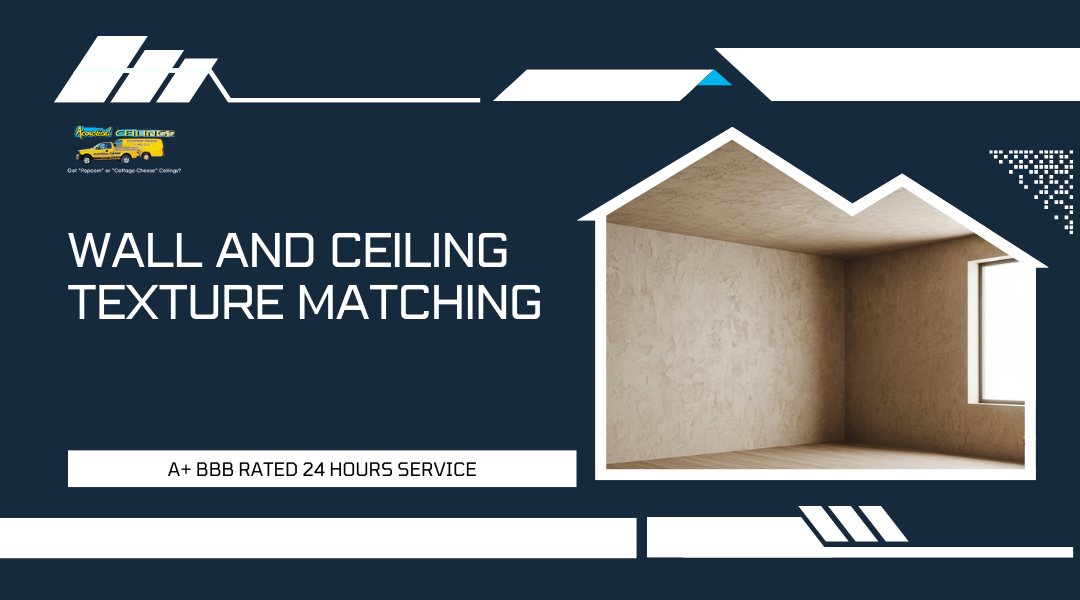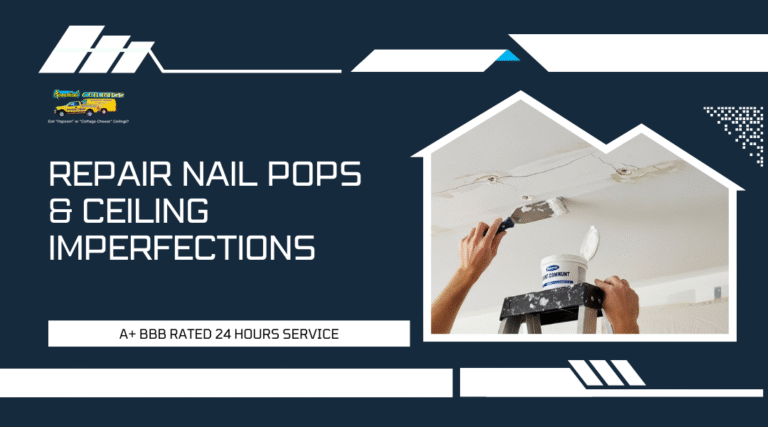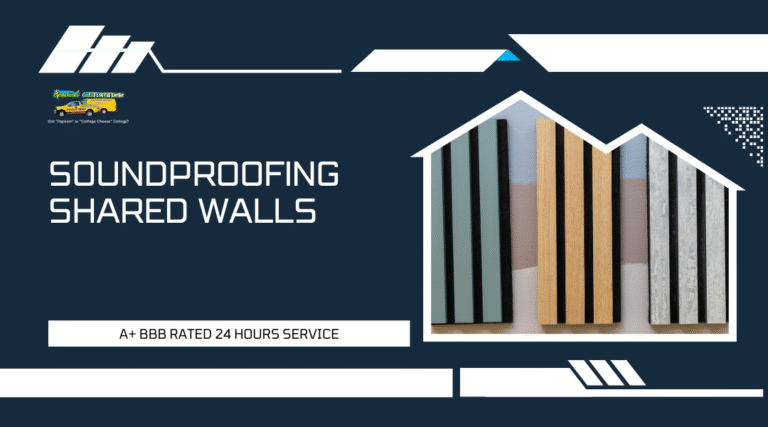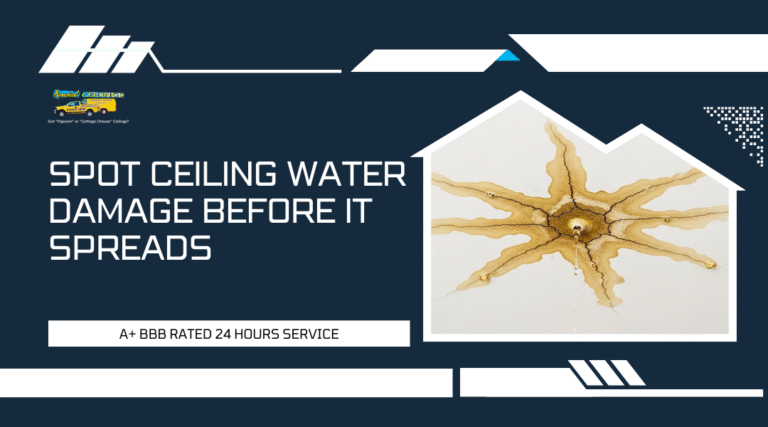When updating or repairing your home, one of the most common design questions is whether the walls and ceilings should share the same texture. You don’t have to keep them consistent—matching can create a uniform look, but adding contrast often enhances depth and style. The right choice depends on your design goals, the condition of your surfaces, and how much maintenance you want to handle.
Ceilings often benefit from heavier textures that hide imperfections, while walls usually work better with smoother finishes that are easier to clean. By balancing these differences, you can create a space that feels polished without looking flat or outdated. Texture matching after repairs also requires skill, since even small inconsistencies can stand out.
At Acoustical Ceilings in Rancho Cucamonga, you gain access to decades of expertise in drywall and texture application. Whether you want seamless consistency or subtle contrast, you’ll find professional guidance to achieve the look that fits your space best.
Understanding Wall and Ceiling Textures
Wall and ceiling textures affect how surfaces look, how light reflects in a room, and how imperfections are hidden. They also influence maintenance needs and the type of repair methods you may use over time.
What Texture Finishes Are Commonly Used?
You will encounter several common finishes, each with its own application method and appearance. Orange peel is one of the most widely used wall textures, featuring a light, dimpled surface that softens flat drywall without being too bold. Knockdown texture creates a stucco-like effect by spraying compound and then flattening the peaks with a trowel.
For ceilings, popcorn texture was popular for decades because of its sound-dampening qualities and ability to hide flaws. However, it has fallen out of favor due to its dated look and difficulty in cleaning. Stomp texture and comb texture are also options, offering more decorative patterns.
In addition to sprayed finishes, you may also see textured tiles or panels used on ceilings. These can mimic natural textures such as stone or plaster while offering easier installation and replacement. The choice often depends on the style of the space and how much maintenance you want to handle.
The Purpose of Textures Beyond Aesthetics
Textures do more than add visual interest. They help conceal seams, nail holes, and surface irregularities that would be noticeable on smooth drywall. This makes them especially useful in large rooms where light can highlight flaws.
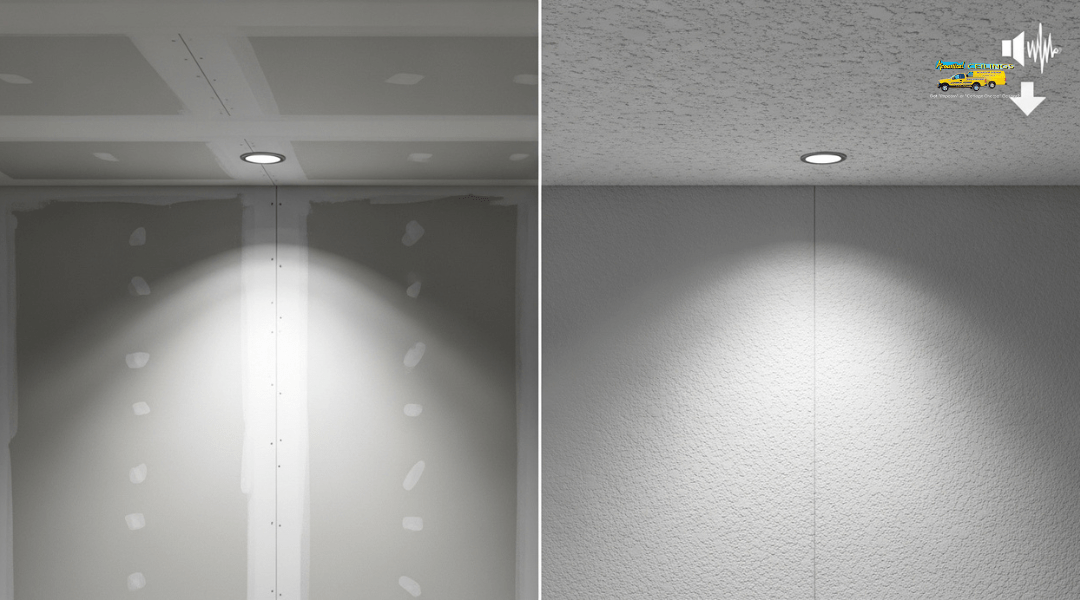
Another benefit is how textures affect light reflection. A flat wall reflects light evenly, while a textured surface scatters it, reducing glare and creating softer shadows. This can make a space feel more balanced.
Some ceiling textures, like popcorn, also serve a functional role in acoustic control. By diffusing sound, they reduce echo and noise transfer between rooms. Even modern alternatives like knockdown or sprayed finishes provide some degree of sound absorption compared to smooth drywall.
Differences Between Wall and Ceiling Applications
You often see lighter, more subtle textures on walls and heavier finishes on ceilings. Walls benefit from finishes like orange peel or knockdown that provide visual depth without being distracting. Ceilings, on the other hand, often use bolder textures to hide imperfections in large, flat areas.
Application methods also differ. Wall textures are usually applied with rollers, spray guns, or trowels, while ceilings often rely on spraying techniques for faster coverage. Some ceiling textures, such as popcorn, require special removal considerations due to potential asbestos in older homes.
Maintenance is another point of difference. Walls are more likely to be patched, repainted, or refinished, so you need a texture that can be repaired without standing out. Ceilings are less frequently altered, which makes long-lasting finishes or textured tiles more practical.
Should Walls and Ceilings Match in Texture?
The choice between matching or contrasting wall and ceiling textures depends on how you want the space to feel and function. Texture can influence room size perception, highlight focal points, and affect overall interior design balance.
Benefits of Keeping Textures Consistent
Using the same texture on both walls and ceilings creates a unified appearance. This approach works well in smaller rooms because consistent surfaces can make the space feel larger and less segmented.
A smooth texture on both surfaces provides a clean, modern look. It minimizes shadows and keeps the focus on furniture or décor instead of surface details. This is especially effective in contemporary interior design where simplicity is valued.
Consistent textures also help hide imperfections. For example, a light orange peel finish across walls and ceilings can disguise uneven drywall seams while maintaining a cohesive look.
When you want an uninterrupted flow between vertical and horizontal planes, matching textures is often the most practical choice. It reduces visual clutter and ensures your ceiling doesn’t compete with the walls for attention.
When Contrast Between Wall and Ceiling Works Better
In some spaces, contrast between wall and ceiling textures enhances visual interest. A smooth ceiling paired with textured walls creates a clear distinction that can emphasize ceiling height.
This approach is useful when you want the ceiling to recede in importance. By keeping it smooth and neutral, the eye is naturally drawn to the walls, artwork, or furniture.
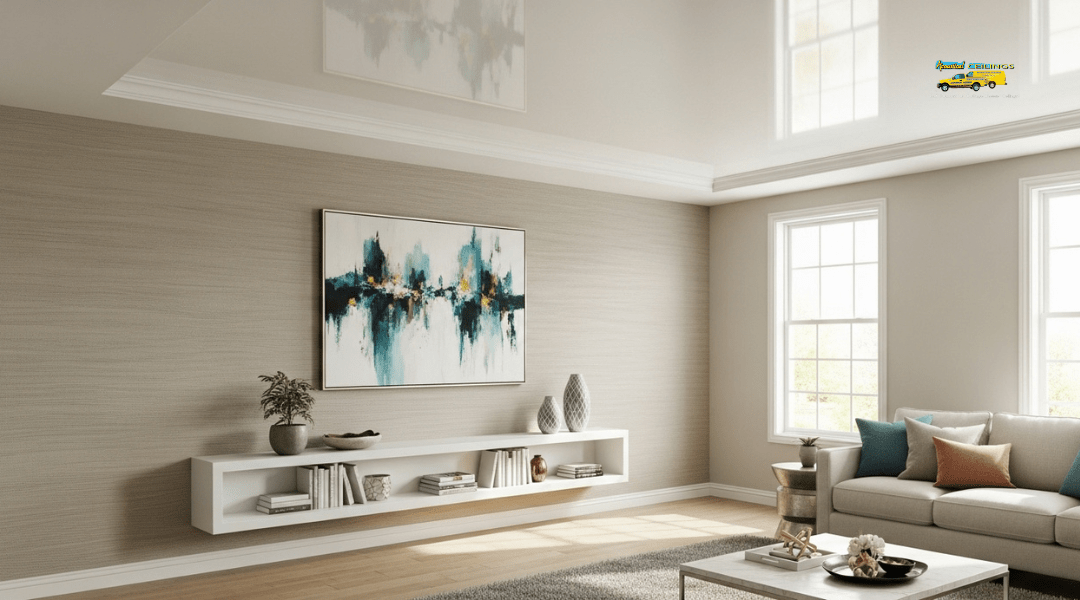
Contrast also works well in larger rooms where uniformity might feel flat. For example, combining a knockdown ceiling with smooth walls can add depth without overwhelming the design.
You can also use contrast to establish focal points. A subtle ceiling texture paired with bolder wall finishes can direct attention toward architectural details, such as crown molding or built-in shelving.
Design Factors That Influence the Right Choice
Your decision should account for room size, lighting, and intended style. In low-ceiling rooms, smooth ceilings help create openness, while textured ceilings may make the space feel smaller.
Lighting plays a major role. Overhead fixtures can cast shadows on textured ceilings, highlighting patterns more than expected. If you prefer a softer look, smoother finishes work better with direct lighting.
Interior design goals should guide your choice. For a modern style, smooth surfaces are often preferred. For traditional or rustic spaces, textured ceilings can complement natural materials and add character.
Budget and maintenance also matter. Textured ceilings can hide flaws but are harder to clean, while smooth finishes require more precise installation but are easier to repaint.
Practical Considerations for Texture Matching
When deciding whether to match wall and ceiling textures, you need to think about how the finish affects space perception, how it aligns with your home’s architectural style, and whether you’re working on a renovation or new build. Each factor influences both the look and practicality of your design choices.
Impact on Room Size and Lighting Perception
Texture changes how light interacts with surfaces. A smooth ceiling reflects light evenly, which can make a room feel brighter and more open. Heavier textures, like knockdown or popcorn, diffuse light and may create shadows that slightly lower the sense of height.
If your room has limited natural light, a consistent smooth finish on both walls and ceilings can help maximize brightness. In contrast, using texture only on the ceiling can reduce glare from overhead fixtures and soften the atmosphere.
Small rooms often benefit from uniform finishes because they create a seamless look that reduces visual breaks. Larger rooms, especially those with vaulted ceilings or exposed wooden beams, can handle contrasting wall and ceiling textures without feeling disjointed.
The Role of Home Style and Architecture
The architectural style of your home should guide your decision. In modern or minimalist homes, smooth ceilings paired with clean wall finishes complement straight lines, tile backsplashes, and simple cabinetry. Matching textures here may overwhelm the design.
Traditional homes with crown molding or coffered ceilings often look more cohesive when walls and ceilings share a similar finish. A light knockdown texture on both surfaces can highlight trim details without drawing attention away from them.
Rustic or farmhouse interiors with exposed beams or natural wood accents usually benefit from contrast. A textured ceiling paired with smoother walls helps balance the visual weight of wood while keeping the room from feeling too heavy.
Matching in Renovations vs. New Construction
In new construction, you have more freedom to choose a consistent approach because all surfaces start fresh. Matching textures can simplify the finishing process and reduce labor costs, especially when drywall installation is done in one phase.
Renovations often present challenges. If you remove a popcorn ceiling or patch drywall, achieving a perfect match with existing wall textures can be difficult. In many cases, contractors recommend retexturing an entire surface for consistency.
When updating kitchens or bathrooms, consider how wall textures interact with tile backsplashes. Smooth finishes near tile edges create cleaner transitions, while heavy textures may look uneven or unfinished. Matching becomes less about uniformity and more about practicality for long-term maintenance.
The Challenges of Texture Matching After Repairs
Matching wall and ceiling textures requires attention to detail because age, material differences, and lighting make inconsistencies stand out. Even small repairs can look obvious if the texture pattern, application method, or finish does not align with the surrounding surface.
Why Matching Old and New Surfaces Is Difficult
Older surfaces often change color and density over time due to aging paint, dust, or exposure to moisture. This makes new compound or paint look slightly different, even if the same product is used.
Ceiling textures like popcorn, knockdown, or orange peel are especially tricky. Each has a unique pattern that depends on the original tools, spray settings, and thickness of application. Without replicating these conditions, repairs can look uneven.
Lighting also plays a major role. Ceiling lights or natural sunlight cast shadows that highlight even small differences in texture depth. This makes blending more challenging compared to flat wall repairs.
Techniques Professionals Use to Blend Seamlessly
Skilled contractors often test materials and tools on scrap drywall before applying them to your surface. This allows them to adjust spray distance, nozzle size, or trowel pressure until the pattern matches closely.
For small areas, pre-mixed patching compounds combined with stamping or sponge methods can replicate subtle textures. For larger sections, professionals may use a hopper gun with adjustable nozzles to control spray density and coverage.
Feathering edges is critical. By applying lighter texture at the perimeter and heavier coverage in the center, the repair blends into the surrounding surface. Priming and repainting the area—or the entire wall or ceiling—ensures color consistency.
Common Mistakes Homeowners Make with DIY Repairs
Many homeowners apply too much compound at once, creating thick patches that stand out against the original finish. Others skip sanding or feathering, which leaves visible ridges around the repair.
Using the wrong tools is another common issue. For example, trying to mimic a sprayed knockdown texture with only a brush often produces a poor match.
Another mistake is failing to prime before painting. Without primer, new compound absorbs paint differently, making the repair area appear darker or lighter than the rest of the surface.
Expert Advice from Acoustical Ceilings in Rancho Cucamonga
When updating your walls or ceilings, matching the existing texture plays a direct role in how seamless the finished space looks. The right approach depends on knowing local preferences, applying consistent techniques, and relying on skilled workmanship that prevents costly corrections later.
Local Insights on Popular Texture Styles
In Rancho Cucamonga, you’ll find a mix of traditional and modern texture preferences. Many homeowners still choose knockdown or orange peel finishes because they provide a clean look while hiding small drywall flaws. These textures remain practical and widely accepted across Southern California homes.
For older properties, popcorn ceilings are still common, though many owners now request removal due to age, wear, or potential asbestos concerns. In newer builds and remodels, smoother finishes and Santa Fe textures are gaining popularity for their more updated appearance.
If you’re considering decorative options, coffered or recessed ceilings add depth and design interest. These styles are less common but stand out in higher-end renovations. By understanding which finishes are most common in your area, you can make choices that fit both your home’s style and neighborhood standards.
How Our Team Ensures a Consistent Finish
Texture matching requires more than applying compound to drywall. You need the right mix of materials, tools, and application methods to replicate an existing surface. At Acoustical Ceilings, every project starts with assessing the current texture under different lighting conditions to see how shadows and surfaces interact.
We use specialized tools such as spray hoppers, trowels, and brushes to recreate finishes with precision. Matching isn’t just about appearance—it also involves blending edges so repairs don’t stand out once painted.
Our process often includes testing small areas before completing the full repair or installation. This step ensures the final result blends seamlessly with the rest of your wall or ceiling, reducing the chance of visible mismatches.
Why Professional Work Saves Time and Avoids Re-Work
Attempting texture matching on your own can lead to uneven patterns, visible seams, or wasted materials. Even small mistakes often require sanding, reapplying, or starting over, which adds time and expense.
By hiring professionals, you avoid these setbacks. Our team has decades of experience with drywall repair, popcorn ceiling removal, and decorative finishes, which means the work gets done correctly the first time.
You also benefit from efficiency. We complete projects faster because we already know the techniques and have the equipment on hand. This reduces disruption in your home and ensures you don’t spend more money fixing preventable errors.

